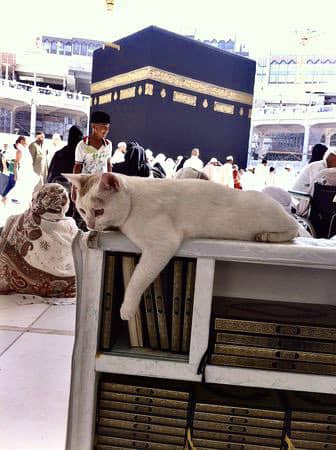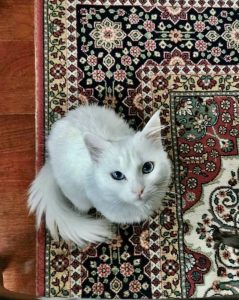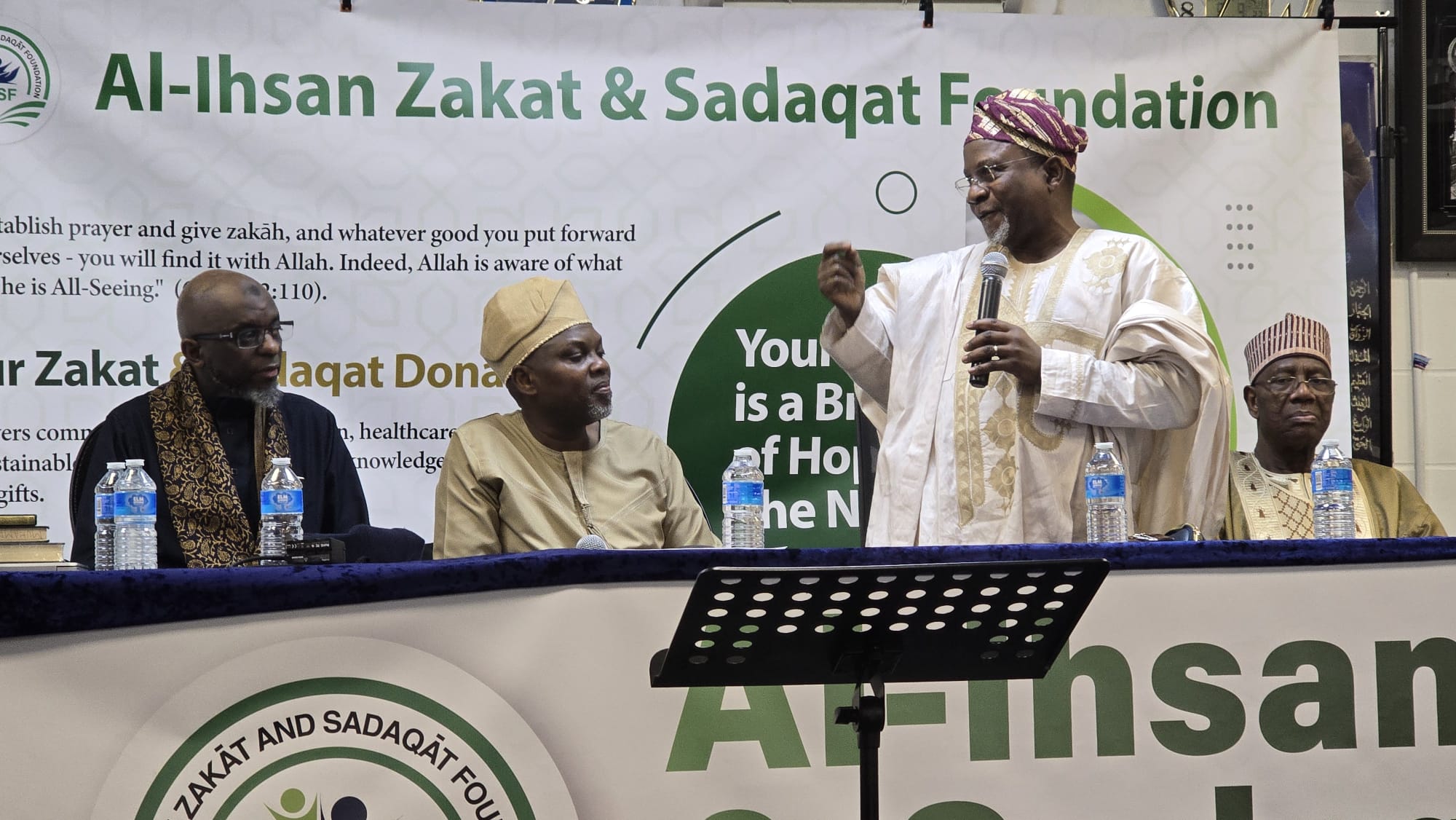Supreme Court cancels Tinubu’s clemency, sentences Maryam Sanda to death
December 12, 2025Ex-labour minister Ngige arraigned, remanded in Kuje prison
December 12, 2025The Semiotics of the Cat on Imam’s Shoulder during the Muslim Worship
The Semiotics of the Cat on Imam’s Shoulder during the Muslim Worship

By Waheed Bamigbade
A 30-second video has recently surfaced on the internet of a Muslim congregation in a mosque observing the taraawiy solat while a cat came around, jumped on the Imam’s chest, who gently cuddled it with his two folded arms and helped it up his body. The cat then climbed up to the Imam’s shoulder and stayed there for some time.
The video is currently trending on the various social media platforms and has been featured on CNN and BBC, and viewed by hundreds of millions of people. There are an estimated 400 million cats all over the world (Nelson Sarah, 2021).
According to Crystal (2022), cats “move with a sense of purpose. They seem to glide effortlessly across the ground, winding through furniture and around obstacles as if they had a sixth sense guiding them”.
A semiotic reading of this short video calls attention to the beauty of the religion of Islam where love for all creatures of God, including animals has been vividly demonstrated.
Aside the uses of cats to solve the problem of rodents and pests at home and in farms for centuries, in some climes and cultures, a cat denotes certain evil and should not be seen around places of worship.
As shown above, cats are regarded quite differently in cultures around the world. Jeffrey Vadala (2019) in a well researched article titled ‘The Wild World of Cat Beliefs’ argues that “cats can be viewed as messengers of good omens (Persian), bad omens (Persian and Azande), magical beings used to induce rains as well as transform into genies (Persian) or sorcerers (Yucatec)”.
According to Malek (1997), Egyptians venerated cats while worshiping cat-deities that represented fertility, power, and justice.
According to Vadala (2019),
In the Yucatan, Maya sorcerers are thought to have the ability to transform into several forms of domestic animals, including cats. A shape-shifting sorcerer that can turn into a cat is called a “uay-miz” or cat sorcerer. Redfield and Villa Rojas note that anyone can learn how to transform into a spirit-animal if they wish to “traffic in evil” (1962:178). This ability is predicated on the Maya belief that human souls can be connected to animals like cats (Descola 2013). This belief is fairly common in the Maya culture and these animal transformations are often not taken seriously. It is believed that sorcerers transform into cats simply to create mischief and pranks (Villa Rojas 1945:136).
Vadala continues:
In Azande (sic) society, located in North Central Africa, a wild cat called an adandara is feared and thought to be an extremely deadly omen (Evans-Pritchard 1963). Just seeing the adandara can cause a person’s death. Associated with witchcraft and lesbianism, these cats have bright bodies with large eyes that gleam in the night while they produce an extremely shrill sound (Evans-Pritchard 1963, 1970:1432). Evans-Pritchard (1937:51) notes that in Zande mythology it is believed that on rare occasions “male cats have sexual relations with women who give birth to kittens and suckle them like human infants.” It is thought that this power is transmitted through witch families from generation to generation (Evans-Prichard 1937:55). In one example, Evans-Pritchard (1971:371) describes how these “witch-kittens” are so terrifying that even the military feared and avoided them.
Vadala argues further that among the Persians, cat is a dangerous animal. In his words,
…cat behavior can be associated with very dangerous omens. For instance, if a cat rubs its face on a person, it is a sign of impending danger. In regards to feline brawling, Massé and Messner (1954) state that “when two cats fight they must be separated quickly, or some difficulty will arise”. Perhaps the worst omen related to cats is a dead cat found in the house. It thought that a dead cat must immediately be expelled from the house to ward off “imminent misfortune” (1954:189).
The evil attached to the cat as an agent of sorcery is well encapsulated by Vadala as follows:
It is also commonly thought that black cats are entities called djinn, more commonly known as “genies” in English. Given that djinn are powerful and dangerous spiritual creatures, mistreating black cats is therefore a risky proposition. If a djinn is harassed or tormented, a fainting spell will come upon the harasser. Furthermore, it is thought that if a black cat enters a room at night, it must be greeted just in case it is a maleficent djinn. The risk of an immediate induced psychological state of insanity is a possible side effect of improperly greeting such a special guest (Massé and Messner, 1954:352).
Furthermore according to Cirlot Je (1967), cats were associated with certain goddesses (pg. 38), while in the Norse mythology in Europe, cats were also associated with certain goddess from whom they sought protection for their crops by leaving pans of milk in the field for the goddess’s cats (Howey, 2003).
In most parts of the world, including the United States and Western Europe, cats have been associated with bad omen rather than good.
Accordingto Sarah Nelson (2021),
many cats were killed in Europe in the middle ages as they were believed to be associated with witchcraft. It is suspected that due to the decrease of the cat population it encouraged the spread of the bubonic plague from 1346 – 1353 because of the lack of predators keeping the rat population in check.
The black cats have been mostly associated with bad luck, witchcraft and death. Ironically however in the United Kingdom, while the black cat is associated with good luck and sailor’s safety, the white cat is associated with bad luck (de Vries, 1976; Eyers, 2011).
During the Renaissance period in England, cats were regarded as witches, and were sometimes burnt alive during festivities or thrown off buildings. For example, according to Elena Nastyuk (2019), cats were
a matter of the superstitious fear (due to their marked propensity towards nightlife). It was believed that the devil often disguised as a black cat. That’s why cats were usually depicted perching on the shoulder of their mistresses, who were witches. For example, in his Last Supper, Domenico Ghirlandaio (1449−1494) painted the cat sitting behind the figure of Judas Iscariot, who betrayed Christ, thereby continuing the medieval tradition of hostility towards an animal, symbolizing betrayal in this story.
In modern times however, cats are being increasingly seen as a benevolent and affectionate animal, and have become popular domestic animals, and according to the Dickinson (1990) in the New York Times, cat has become the most popular subject and its pictures often appear on gift items in the United States (Dickinson, 1990) and on social media.
According to Crystal (2022), cat symbolizes grace, intelligence and cunning, being quite agile and nimble, moving with silence and stealth; it symbolizes independence – it is able to live on its own terms, and dislikes being tamed or controlled; it symbolizes resourcefulness and persistence as it is not easily deterred and can adapt to most situations and survive. Cats are quite explorative, living a life of curiosity and adventure.
In Islam, cats are taught to be well-cared-for, treasured, appreciated and loved. They are admired for their cleaningness and considered the quintessential pet by Muslims. Generally, animals must be protected, and in one hadith, the Prophet Muhammad specifically prohibited the persecution and killing of cats. He said: “have mercy on the creatures of God so that God can be merciful to you too”.
Abu Huraira (father of cat/kitten) was one of the prominent companions of the Prophet Muhammad (pbuh), and was so named because he owned and always carried about a cat or kitten.
The Prophet told the story of a woman who who would enter hellfire for persecuting a cat and a prostitute who would be forgiven for giving water to a dog that was dying of thirst. Juan Eduardo Campo (2009) narrates that
the American poet and travel author Bayard Taylor (1825–1878) was astonished when he discovered a Syrian hospital where cats roamed freely. The institution, in which domestic felines were sheltered and nourished, was funded by a waqf, along with caretakers’ wages, veterinary care and cat food. Edward William Lane (1801–1876), a British Orientalist who resided in Cairo, described a cat garden originally endowed by the 13th-century Egyptian sultan Baibars, whose European contemporaries held a very different attitude towards cats, eating them or killing them under papal decrees.
In Islam, cats are ritually clean, and can enter homes and mosques including the Masjid Al- Haram in Makkah and Madina, unlike the dogs. Food and water sampled by cats are okay for Muslims to eat and drink and use for ablution.

The urine of a cat on clothes is not regarded as dirt while the saliva of a dog on a cloth must be rinsed seven times and the last being with sand before such a cloth can be used to pray solat.
According to Ekrem Buğra Ekincidec (December, 2017),
there is a mosque in Damascus called Masjid al-Qitat. “Qitat” means “cats” in Arabic. It is also a foundation that was established to protect the cat thrown out in the street. The caretaker of the mosque purchases liver with the some of the foundation’s income and feeds hundreds of cats every day. İsmail Saib Sencer, the director of the Bayezid Library in Istanbul, fed hundreds of cats. For this reason, Bayezid Library was called “The Cat Library.”
The Qitat Mosque was donated under Islamic Law In 1267 as a charitable foundation established to protect cats. This endowment set up 800 years ago is still thriving and taking care of cats.
The Prophet Muhammad is reported to have said: “Verily, there is heavenly reward for every act of kindness done to a living animal.” The way the Imam in the trending video has treated the cat that came to him while on solat is a thing of admiration, implicating a gentle, compassionate and beautiful heart.
The semiotics (the signification) of the cat on the Imam’s shoulder is that of peace, mercy and compassion. The event signifies mercy and compassion for the weak, for animals, for the less-privileged; it signifies peace with himself, peace with his environment, peace with all creatures, and peace with God who creates him and the animal. It signifies the height of mercy, compassion for and peaceful coexistence with animals and humans alike. God says in the Qur’an Chapter 21 Surah Al-Anbiyaai verse 107: 107: “We sent thee not, but as a Mercy for all creatures”.
Islam is therefore a culture of mercy and compassion which is completely at peace with humanity and its environment.
If Islam can preach and practice this level of compassion and love for an animal, the love and compassion that is given to the life, person and dignity in Islam is much more great and awesome. God says in Qur’an Chapter 5 Surah Maidah:
32. On that account: We ordained for the Children of Israel that if any one slew a person – unless it be for murder or for spreading mischief in the land – it would be as if he slew the whole people: and if any one saved a life, it would be as if he saved the life of the whole people. Then although there came to them Our messengers with clear signs, yet, even after that, many of them continued to commit excesses in the land.
In his famous sermon during his last pilgrimage, the Prophet (PBUH) firmly declared: “the blood of human being, their property and prestige are as sacred as the city of Harram of Makkah and the day of Arafah”. This therefore negates and belies the negative image that the western press and their stooges are struggling to confer on Islam and Muslims, as the guidance of God in the Qur’an and the Sunnahof His Prophet Muhammad is very clear and unambiguous. Therefore in Islam, no life is worthless and deserving of being discarded regardless of the social, political, religious, ethnic, educational, linguistic, economic and medical status of the person.
What is Islam is Islam, and what is not Islam can never be Islam. In Islam, the blood of a human being is sacred, and killing one human being, without a duly constituted judicial authority, is not only the most heinous crime, but it is also equivalent to killing the whole of mankind.
Prophet Muhammad (SAW) reportedly stated that the first act of Allah on the Day of Judgment would be to punish murderers by making them suffer the torment of Hell. It therefore stands against reason that some people would still attribute terrorism to Islam even without any iota of evidence to support such an audacious and shameful claim
Dr. Waheed Bamigbade, a guest writer, sends in this contribution from the Obafemi Awolowo University, Ile-Ife, Osun State, Nigeria, and can be reached on 08142571571 (whatsapp only).










